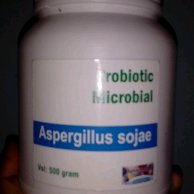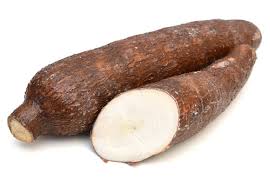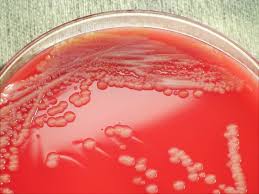Aspergillus sojae
Jual Culture Aspergillus sojae
087731375234
Studies of A. oryzae and A. sojae strains used for shoyu production have focused on comparing these two fungal species and improving their enzyme-producing abilities. A study of the enzymatic differences between 11 strains of A. oryzae and 20 strains of A. sojae showed that the activities of neutral, acid, and alkaline proteases, xylanase, pectin lyase, phosphatase, and aminopeptidase were not significantly different. However, acid carboxypeptidase activity and α-amylase activity were higher from A. oryzae when compared with A. sojae strains, while endopolygalacturonidase activity was much higher from A. sojae than from A. oryzae (Terada et al., 1980). The ratios between α-amylase activity and endopolygalacturonidase activity of 0.5–2 for A. sojae and 20–2000 for A. oryzae were suggested as a differentiation criterion for the species (Terada et al., 1980). Hayashi et al. (1981) compared the performance of these two fungi in shoyu production. They found that the activities of protease, acetic carboxypeptidase, and α-amylase were lower and those of endopolyglueuronidase and glutaminase were higher in koji made with A. sojae. In the moromi stage, the proportions of NH3 nitrogen (N), glutamic acid N, and total Ν were higher, and viscosity and heat residue were lower with A. sojae. The resulting concentrations of citric and succinic acids in the shoyu were significantly higher (p < 0.001) with A. sojae than with A. oryzae. Ishihara et al. (1996) compared the volatile components in commercial koikuchi shoyus from different factories using either A. oryzae or A. sojae and found that the concentrations of 1- and 2-propanol, furfuryl and benzyl alcohols, ethyl-benzoate, and lactate, acetate, pyrazines, carbonyl compounds such as ethanal, maltol, and phenyl acetaldehyde, phenol, and others, were higher in the shoyu from factories using the latter fungus, but concentrations of 2-methyl- and 3-methyl − 1-butanol, 2-phenyl ethanol, 2-methyl- and 3-methyl-butanoic acid, 3-methylthio − 1-propanol, HEMF, 4-ethyl guaiacol, 4-ethyl phenol, and others were greater in shoyu from factories using the former fungus. These results have prompted factory managements to use A. sojae for koji production.
Using an unusual system, Yasui et al. (1982) tested a range of koji fungal strains for glutaminase production and found that, when a strain showing 16% higher glutaminase activity than its parent strain was compared with its parent in the production of shoyu, the final glutamic acid concentration was 10% higher.
In the early 1950s, A. sojae KS was irradiated with X-rays by Iguchi to produce strain X-816 of A. sojae (Sekine et al., 1970). Sekine et al. (1970) obtained seven strains with superior alkaline phosphatase activity (130–190%) and highly active protease, peptidase, cellulase, and amylase activities that were better at decomposing soybean protein. Yokoyama and Kadowaki (1983) UV-irradiated A. sojae strain Η and obtained mutant strains with total protease activities 2.5 times that in wheat bran and soy sauce kojis. The mutant strains were diploidized and combined with natural mutants from Μ strains, and strains TH and D-15 were produced that possessed higher total protease activities than the Μ strains, and grew well. However, UV irradiation may stimulate the production of toxic elements in otherwise safe fungi. Kalayanamitr et al. (1987) UV-irradiated A. flavus var. columnaris Raper and Fennel (ATCC44310) to obtain mutant strains with high protease and amylase activities, and light-colored conidia. Some selected mutant strains were found to be acutely toxic to weanling rats, even though they were negative for aflatoxin production. The investigators suggested that the toxic compound could be one of four substances: maltorhyzine, aspergillic acid, kojic acid, or cycoopiazonic acid.
Furuya et al. (1983) fused, with an efficiency of 1%, protoplasts derived from two strains of A. oryzae, one with a high growth rate and the other producing high levels of protease. Two strains derived from successful fusions showed high stability, fast growth, and abundant sporulation and produced 2.3 times more protease than the parent fast-growth strain.
The growth and development of microorganisms on defatted soybean and ground wheat koji prepared with A. sojae were studied by electron microscopy by Kitahara et al. (1980). Growth of the mold on the surface of the soybean was rapid up to 24 h, at which point formation of sporing bodies began, and spores were released within 40 h. However, very little fungal growth was seen on the wheat surface, but yeasts were seen growing on the wheat. Growth of Micrococcus species became noticeable after 16 h, as did multiplication of lactobacilli. These observations on the growth of the koji mold are at odds with the observation that 10–20% of the dry matter in koji is lost in the koji stage (Takeuchi et al., 1968) and the observations below on the significant consumption of carbohydrate during the koji stage. I suggest that significant penetration of the wheat endosperm should have been seen.
During koji production, carbohydrate is consumed by the fungus, thus leaving less carbohydrate available to provide flavor compounds for the final shoyu produced (Furuya et al., 1985). This carbohydrate consumption is positively correlated with α-amylase activity in koji culture. To overcome the depletion of carbohydrate before the moromi stage, Furuya et al. (1985) derived mutants that utilized 10–50% less carbohydrate during preparation of koji than the parent strain, with about 1/3, 1/20, and 1/150 of the α-amylase activity of the parent strain of A. oryzae. Significantly increased amounts of carbohydrate-derived compounds were found in the resulting shoyu made with these mutants.
Enhanced glutaminase activity in koji is desirable to increase glutamic acid production in soy sauce, and reduced conidial production in the koji reduces contamination of the air with floating conidia (Ueki et al., 1994a). A mixed tane koji of two koji fungi, A. oryzae strains K2 and HG, increased glutaminase activity of the mixture to 11.3 units · g− 1 dry koji, which was higher than the 4.7 or 4.4 units · g− 1 dry koji produced by the K2 strain or HG strain, respectively, and conidia production was reduced tenfold (Ueki et al., 1994a). The mixed tane koji was used in the manufacture of soy sauce, and the resulting mixed koji made with 3.6 tons of defatted soybean and of wheat grain showed high glutaminase activity (5.5 units · g− 1 dry weight koji) when compared to strain K2 alone (1.8 units · g− 1 dry weight koji). In addition, the number of conidia in the mixed culture was 2.5 × 107 g− 1 dry koji, which was lower than 1.3 × 108 g− 1dry koji produced by strain K2 alone. The glutamic acid content of the raw soy sauce was 1.25 times higher than the glutamic acid level found in normal soy sauce (Ueki et al., 1994b).
Kim and Cho (1975) investigated soy sauce production in Korea using a soy–wheat koji prepared with A. sojae, using natto, a soy bean product prepared with Bacillus natto, and using a mixture of the two in varying proportions. The natto–brine mixture had protease activity twice as high as the koji alone, and this was reflected in the protease activities found in mixtures of the natto and koji. On comparing the organoleptic qualities of soy sauces fermented for 3 months, the koji:natto at a ratio of 6:4 had the best flavor, followed by koji alone.




Komentar
Posting Komentar